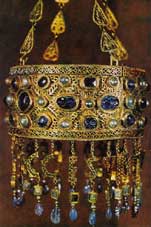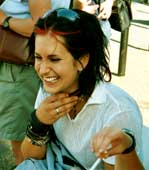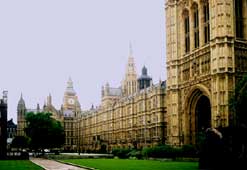 |
Patrick Delaforce & Ken Baldry'The Delaforce Family History'
|
Chapter 45
"Your opponents are in front of you - your enemies are behind you" political motto
Gothic triumph & disaster
|
Leovegilde & Théodora’s other son, Recarred Balt King of the Visigoths 586-601 (?559 - 601) is a very important figure. He had a wife, Bauda Afonso (abt 580 - ?) & a son, Suintila (Swinthila) Balthes (?584 - 635). Recarred was responsible for the wholesale conversion of Spain to Catholicism from Arianism, all of which he now ruled with a rod of iron, thanks to his father clearing the Byzantines out of Cordova. The conversion was doubtless, a shrewd political manoevre, as the Orthodox Christianity of the Byzantines more resembled the traditional Arianism of the Goths & Recarred needed the national unity a common religion would assist, just in case the Byzantines, still a very powerful voice in the Dark Age world, tried to come back, as they had in the past. The whole Western World must have had it in the backs of their minds for several centuries, that maybe the Romans (even if in the form of the Greek Empire of Byzantium) might manage a comeback, to everyone’s embarrassment. The conversion was very well managed, with a lengthy conference to discuss it. Incredibly, the full minutes of the conference have survived. In fact, the Catholics did not have it all their own way. Recarred’s son Liuva succeeded him for a couple of years but was murdered by Witteric, the leader of the Arian faction. Witteric hung on for seven years before, he, in turn, was murdered (if that is the appropriate verb). But these people, unlike Recarred, were not Delaforces. Until this time too, the original Spanish were still using the Roman legal system & the Visigoth legal system ran in parallel, which must have made for some interesting court cases but now, under Swinthila, theywere finally merged up into a common code. Despite the Catholic conversion, the greatest period of Visigoth civilisation now began. Many gold artefacts and some of the churches still survive from this period.
Recarred also had a relationship with Floresinda & their daughter Theodora married her half-brother Swinthila. They named their son Chindaswind ('son of Swind') (?610 - ?653) & he married Rekiberga (?630 - ?653). Chindaswind was an illiterate roughneck but he did have the wit to make efforts to reconcile the romanised Spanish subjects. His daughter Glasvinda carries part of our line away from the Kings of Spain. She married twice, firstly to Ardabast, a 2nd cousin, once removed, who was descended from the troublesome Hermenegilde. Two question marks hang over their son Ervik. Was his wife the grand-daughter of Suintila? She could not have been the daughter, as several sources have it unless she was the daughter of a young concubine, Theodora being too old at her birth and was it their daughter Alpaide who may have married Pepin the Fat, the great-grandfather of Charlemagne? However, another Alpaide, descended from Clothilde II, is also in the frame. Either way, Glasvinda herself is a Delaforce Granny because secondly, she married Froila Count of Cantabria. Their son Pedro (Pierre but maybe just Peter) ‘the Visigoth’ Duke of Cantabria (670 - ?) fathered Fruela Perez of Bardalia, Duke of Cantabria (?705 - 765?), who seems to have married someone called Gosendes, about whom it has not been possible to discover anything, including whether this is correct. Froila was also an ancestor of Sancho Mitarra, who we will meet in chapter 50. |
|
Chindaswind King of the Visigoths 641-649 (?610 - 1/10/653) = Rekiberga (?630 - ?653)
|

Recceswinth's crown |
|
|
Bermudo I 'the Deacon' King of the Asturias fr 789-791 (?760 - 797) = Ursinde de Nunilon (?752 - ?)
Bermudo abdicated & returned to holy orders. |
He was definitely the father of Ermesinde, the Queen of Alphonse the Catholic, so is a Delaforce ancestor whatever his disputed ancestry from Chindaswind. The daughter of Fruela Perez & Gosendes was Numabela, who was married off to Loup II, Duke of Gascony. One can see the military/political point of this. Her cousin, Fruela the Cruel, consolidated the Kingdom of the Asturias but is not one of us, as his son & eventual successor, Alphonso the Chaste was, well, chaste. That is the Delaforce Visigoths sorted out or is it? We must back-track a little. King Roderic was the son of Chindaswind's son, Theodofred. His daughter Egilona married Abdul Aziz (abt 670 - abt 717) Governor of Egypt and who was descended from the Prophet Mohammed. This brought Abdul Aziz, who had been crowned King of Spain, under suspicion back in Damascus. Egilona may not have had much choice, as Roderic was the last Visigoth King of Spain, having been defeated, swept aside & slain by the advancing Moors, lead by Tarik idn Zayad, on July 19th 711 at the Battle of Guadalete, where he was also betrayed by his allies, the sons of the king he had killed to obtain the throne, hence the motto at the head of this chapter. The Moorish advance left little but the north coastal regions protected by the Cantabrian mountains from further Moorish depredations, see Pelayo above. It must be admitted that the Moors, abandoning the feverish Mohammedan compulsory conversion policies of earlier years, won friends by their tolerance of both Christians and Jews & by their taxation policies. Abdul & Egilona’s daughter Aisha married someone called Fortun. His father was another Goth, Cassius Fortunius of Meark. Aisha & Fortun’s son was Musa ibn Fortun, Chief of the Banu Qasi who we met in chapter 42. The next chapter traces the Merovingian contribution to the Delaforce gene pool. |
|
Things Gothic It is strange how some ideas linger in history, well past their era. With the Moorish invasions, the Visigoths became indistiguishable from the Basques & surviving Iberians, having previously decided to sanction interbreeding. The Ostrogoths never kept any power after their defeat by Belisarius, although resistance continued for some years. Yet:- 1. At the Congress of Basel in 1431, the Swedish & Austrian delegates almost came to blows over who was the purer Goth. 2. ‘Gothic’, as a style of architecture has had its ups and downs ever since, with periodic revivals & some architects are still building 'Gothic' in 2005. 3. Some girls go around with heavy black make-up & call themselves Goths. Strangely, this has not suffered the ravages of changing fashion since it came in during the Sixties. There has been a continuous presence of some girl Goths since them. 4. We are all familiar with ‘Gothic’ novels, Victorian horror stories but why Gothic? The best of French cooking is alleged to come from our area of South-Western France & our genealogical researches allowed us to confirm this. It is pleasant to tease the French that this is, in fact, Basque/Visigoth cookery.
What was it about the Goths? |
|
Contact: Ken Baldry for more information, 17 Gerrard Road, Islington, London N1 8AY +44(0)20 7359 6294 but best to e-mail him |





